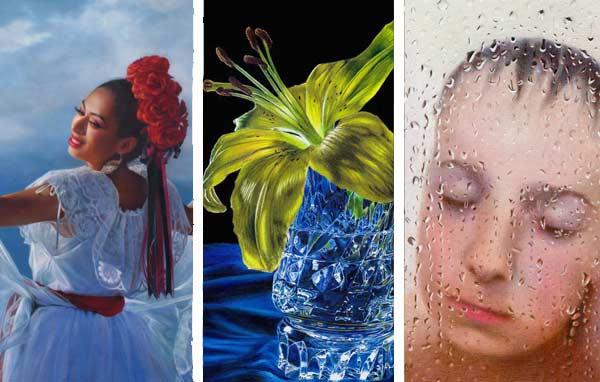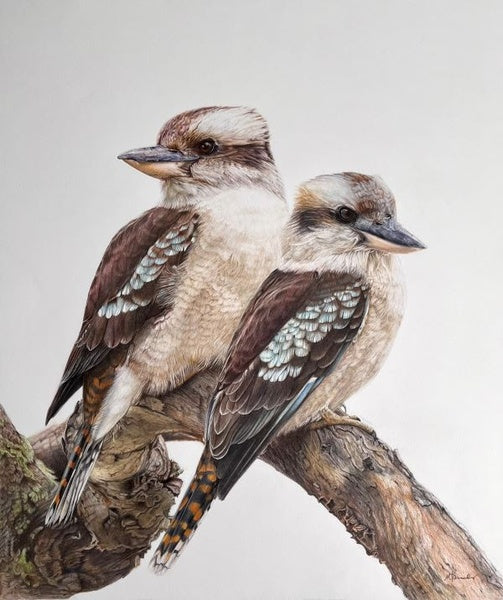Good Enough? Shmood Enough!
by Gabriela Thiecke
When I first got a box of student-grade coloured pencils I was ecstatic every time I used my pencils putting colour to paper and it turned out looking like something recognisable.
Then, many tutorials and experiments later, my enthusiasm began to wane. It wasn't that I didn't still love my, by now, swapped out student pencils for several sets of artist-grade pencils. These were and still are awesome eye candy for me. However, what had happened was that nagging doubts as to whether my art was good enough kept intruding on my blissful state when art-making. Even calling myself an 'artist' sounded fraudulent.
Puppy Love, 18 x 18 cm
Looking for inspiration online and in my art groups on social media I soon realised that self-doubt amongst artists and those daring to call themselves so was quite common. Even among world-famous and highly celebrated artists.
“That nagging doubts as to whether my art was good enough kept intruding on my blissful state when art-making. Even calling myself an 'artist' sounded fraudulent.”
As a case in point, I recently read a fascinating graphic novel about (in)famous Picasso titled “Pablo” by Julie Birmant, which related Picasso's struggle with uncertainty about his art, not to mention the insane level of jealousy that dominated his love life and his toxic envy of his contemporary rivals.
And who hasn't heard about the disturbing accounts of Vincent van Gogh's bouts of depression that drove him to cut off his ear and, finally, shooting himself in a cornfield — but not before making spectacular art which today is celebrated around the world. Did Vincent commit suicide because his art was mostly ignored and went almost entirely unsold during his lifetime? As somewhat radical French dramatist Antonin Artaud later so bluntly put it, van Gogh was “suicided by society.”
Sweet As, 25 x 23 cm
The common factor from these two examples to me is the one thing which, apart from actual art-making, sustains the motivation and emotional well-being of every artist: Appreciation. We artists want to be appreciated — just like anyone else, come to think of it.
However, there is a point at which seeking appreciation becomes destructive and starts to gnaw at your sense of self-worth. As it did for me.
So, I began to ask myself, why am I sitting in solitude for hours, and drawing line upon careful line onto the paper? What is the point of my art-making?
Again I found inspiration from others. In Jerry Saltz' book, How to Be an Artist he says “Art comes from love — love of doing something.” And I'll add that, for me, making art is the love for the subjects I draw. The glint in the eye of an animal or person I draw that makes them come to life, the gleam of a shiny object in its colourful splendour or the magical creations in nature.
“I permitted myself to make art for the sake of expressing on paper what I love and bugger the applause. From then on in, I said I am an artist, without the inward cringe. I began to act as if I was, and so I became.”And whether or not I am accomplished enough in rendering all of this, Saltz has this to say: “Don't be reined in by other people's definitions of skill or beauty, or be cramped by what is supposedly high or low.” Though he also warns, “you're not automatically entitled to applause.”

Spring Blossoms, 21 x 28.5 cm
So, there's that. I decided to take it on board and felt a huge weight lifted off my shoulders. I permitted myself to make art for the sake of expressing on paper what I love and bugger the applause. From then on in, I said I am an artist, without the inward cringe. I began to act as if I was, and so I became.
This “arrogance of belonging” writes Elizabeth Gilbert in her book Big Magic — Creative Living Beyond Fear is “not about egotism or self-absorption. ... It's the opposite; it is a divine force that will actually take you out of yourself and allow you to engage more fully with life. Because often what keeps you from creative living is your self-absorption (your self-doubt, your self-disgust, your self-judgment, your crushing sense of self-protection).”
Wow, what a heavy dose of medicine to swallow. But that exactly described me in my pre-being-an-artist time.
And then, call it serendipity, I stumbled across the Museum of Bad Art (MOBA), with its motto: “art too bad to be ignored.” — Check this out.
Portrait art examples:
http://museumofbadart.org/dopplehangers/
or maybe pet portraits & wildlife?
http://museumofbadart.org/zoo/
And if those pictures hadn't made me feel better about my art, I'd have packed it in. So, thank you to MOBA for sharing “the best bad art ever assembled”, as these pictures certainly taught me to take a more light-hearted approach to art-making.
About Gabriela Thiecke:

After retiring from her naturopathic practice in 2019, Gabriela rekindled her artistic passion that she had let lie dormant for over 40 years. As a teenager, she would draw with a simple graphite pencil, taking her inspiration mainly from postcards that she had collected on family trips around Victoria, Australia. Having since discovered coloured pencils, her artistic signature today can be summed up as bold and vibrant.
See more at: https://www.facebook.com/GabrielasColoredPencilArt/





Comments (2)
Thank you, Gabriela. Lovely piece of inspirational writing. Thank you so much! xxxx
Robin Rudolph - Dec 16, 2022Fabulous points and beautifully written Gabriela… it is so true, and very much food for thought. With focused practice and being kinder to ourselves, we can enjoy creating and keep improving on our creative path.
S Phillips - Dec 16, 2022